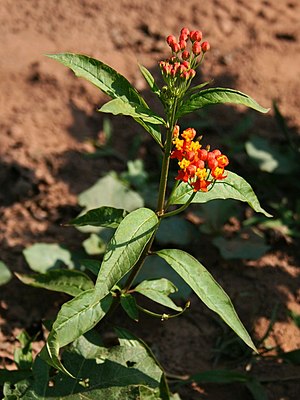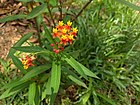Note: This is a project under development. The articles on this wiki are just being initiated and broadly incomplete. You can Help creating new pages.
Difference between revisions of "Asclepias curassavica"
| Line 8: | Line 8: | ||
==Chemical Composition== | ==Chemical Composition== | ||
| − | <ref name="chemical composition"/> | + | Leaves and stems of both plants were analyzed for acid-detergent fiber, acid-detergent lignin, cellulose and ash.<ref name="chemical composition"/> |
==Common names== | ==Common names== | ||
| Line 66: | Line 66: | ||
==References== | ==References== | ||
<references> | <references> | ||
| − | <ref name="chemical composition">[Chemistry]</ref> | + | <ref name="chemical composition">[https://link.springer.com/article/10.1007/BF02861174 Chemistry]</ref> |
<ref name="Leaf">[Morphology]</ref> | <ref name="Leaf">[Morphology]</ref> | ||
<ref name="How to plant/cultivate">[http://tropical.theferns.info/viewtropical.php?id=Asclepias+curassavica Cultivation]</ref> | <ref name="How to plant/cultivate">[http://tropical.theferns.info/viewtropical.php?id=Asclepias+curassavica Cultivation]</ref> | ||
Revision as of 10:23, 30 March 2020
Asclepias curassavica is an annual or short-lived perennial plant.
Contents
- 1 Uses
- 2 Parts Used
- 3 Chemical Composition
- 4 Common names
- 5 Properties
- 6 Habit
- 7 Identification
- 8 List of Ayurvedic medicine in which the herb is used
- 9 Where to get the saplings
- 10 Mode of Propagation
- 11 How to plant/cultivate
- 12 Commonly seen growing in areas
- 13 Photo Gallery
- 14 References
- 15 External Links
Uses
Ringworm, Sores, Rashes, Dermatitis, Dysentery.
Parts Used
Chemical Composition
Leaves and stems of both plants were analyzed for acid-detergent fiber, acid-detergent lignin, cellulose and ash.[1]
Common names
| Language | Common name |
|---|---|
| Kannada | |
| Hindi | |
| Malayalam | |
| Tamil | |
| Telugu | |
| Marathi | |
| Gujarathi | |
| Punjabi | |
| Kashmiri | |
| Sanskrit | |
| English |
Properties
Reference: Dravya - Substance, Rasa - Taste, Guna - Qualities, Veerya - Potency, Vipaka - Post-digesion effect, Karma - Pharmacological activity, Prabhava - Therepeutics.
Dravya
Rasa
Guna
Veerya
Vipaka
Karma
Prabhava
Habit
Identification
Leaf
| Kind | Shape | Feature |
|---|---|---|
Flower
| Type | Size | Color and composition | Stamen | More information |
|---|---|---|---|---|
| {{{5}}} |
Fruit
| Type | Size | Mass | Appearance | Seeds | More information |
|---|---|---|---|---|---|
Other features
List of Ayurvedic medicine in which the herb is used
Where to get the saplings
Mode of Propagation
How to plant/cultivate
Succeeds in a range of climates from warm temperate to tropical.[3]
Commonly seen growing in areas
Pastures, Wastelands, Along roadsides.
Photo Gallery
References
- ↑ Chemistry
- ↑ [Morphology]
- ↑ Cultivation
External Links
- [ ]
- [ ]
- [ ]
Categories:
- Ayurvedic Herbs known to be helpful to treat Ringworm
- Ayurvedic Herbs known to be helpful to treat Sores
- Ayurvedic Herbs known to be helpful to treat Rashes
- Ayurvedic Herbs known to be helpful to treat Dermatitis
- Ayurvedic Herbs known to be helpful to treat Dysentery
- Herbs with Stem fibre used in medicine
- Herbs with Root hair used in medicine
- Habit - Perennial
- Index of Plants which can be propagated by Seeds
- Herbs that are commonly seen in the region of Pastures
- Herbs that are commonly seen in the region of Wastelands
- Herbs that are commonly seen in the region of Along roadsides
- Herbs
- Pages without herbs images




